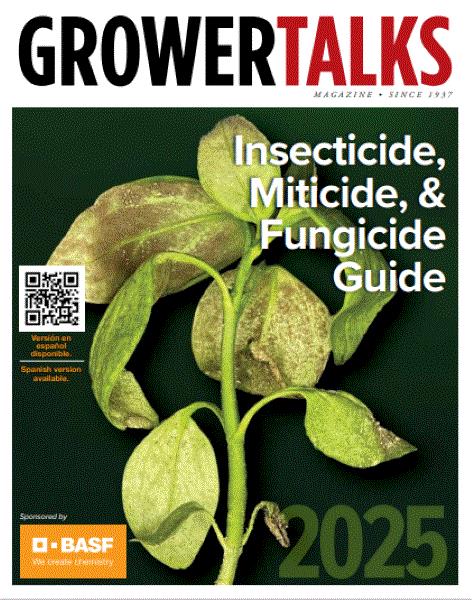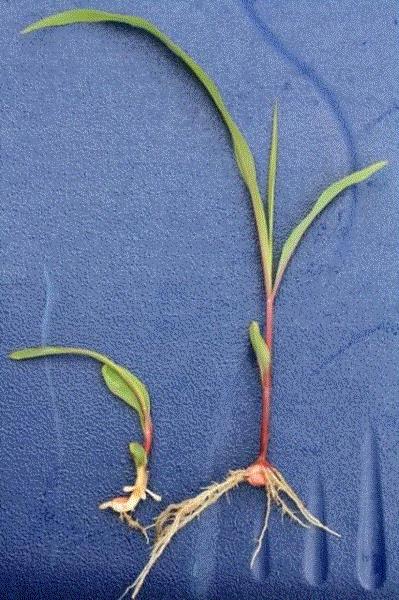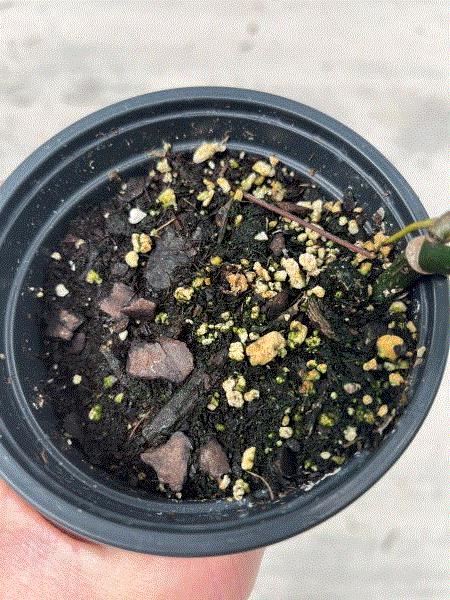The 2025 IMF Guide is Out!
Yes, the 2025 GrowerTalks Insecticide, Miticide, & Fungicide Guide is hot off the presses! Go HERE to download a digital English version. (A Spanish version is coming soon.) BASF is the sponsor of the 2025 IMF Guide.
In addition to the fungicide, insecticide and miticide charts, and the useful disease and pest management programs, I always look forward to learning more about pest management from the great articles that always come with the IMF Guide. This year is no exception.

Francesca Hand of The Ohio State University contributed an article on downy mildew. Some folks I visited in the past year thought downy mildew is a thing of the past and some still struggle with it. It’s a disease we should still pay attention to. Francesca introduces the biology, diagnosis and management of downy mildew in this article.
Tom Creswell and John Bonkowski of Purdue University wrote an article on diagnosing foliar diseases. Tom and John work at Purdue’s Plant and Pest Diagnostic Lab, so you know they have some great pictures on disease symptoms. They also talk about how to best diagnose diseases in your operations.
And for the first time in its history, a preemergence herbicide chart is included in the IMF Guide this year. Okay, I admit I didn’t look at all the versions of this guide, but I’m pretty sure this is the first time in (at least) the last five years when an herbicide chart was included. Chris Marble of the University of Florida compiled the chart. (Note the IMF Guide was sent to the press before the introduction of StriCore [pethoxamid; WSSA 15] in July, so this new preemergence herbicide isn’t included in the chart.)
Accompanying the chart is an article from Joe Neal of North Carolina State University. Joe talks about the importance of making uniform and accurate application of granular preemergence herbicides to get great efficacy and high crop safety. Joe provides a couple of tips on how to achieve uniformity and accuracy.
Lastly, Brandon Christopher of Bell Nursery in Morven, North Carolina, shared his experience and advice on innovating and growing the business. I completely agree with Brandon’s statement that “it’s always evolving, always changing.” Try new things and don’t be afraid to fail, whether it’s using new production approaches or products, or training the next generation in our industry.
Go HERE for a copy of the 2025 IMF Guide.

How Do You Get Rid of Dacthal?
I didn’t mention the news about Dacthal herbicide in the last issue of this newsletter, so here's some background for those who missed it. In early August, U.S. EPA announced a halt of the sale and use of Dacthal or dimethyl tetrachloroterephthalate (DCPA; sometimes listed as chlorthal dimethyl) herbicides immediately. In response to EPA’s decision, AMVAC voluntarily cancelled the registration of Dacthal in late August.
I didn’t talk about Dacthal because I thought, surely, nobody is using DCPA in nurseries and landscapes. That herbicide is old school and also has some nasty health risks. I’m not going to talk about irrelevant things just because I must fill the pages.
Well, I’m correct and wrong at the same time. Very few folks are using Dacthal, but there are a good number of folks who still have some Dacthal in their chemical sheds. Now that no one can use Dacthal legally, what in the world can you do with that jug of Dacthal in the shed? This question makes Dacthal relevant to this newsletter.
For those of you who still have Dacthal it doesn’t matter how much you have and whether it's opened or not, you can return the product to wherever y’all bought it from or contact AMVAC Customer Service at (888) 462-6822 to coordinate product return. The retailers or distributors receiving the returned products will coordinate with AMVAC for pickups. Go HERE for information on returning Dacthal.
Please don’t spray or pour out the Dacthal to save yourself the time and trouble of going down to the store. Return them!

Pendimethalin Crop Safety
I didn’t know pendimethalin (WSSA Group 3) has been around for 30 years. My excuse is I’m not a weed scientist. I dare any weed scientist to tell me when imidacloprid was introduced in the USA. Read on if you want to know the answer. (Coincidentally, DCPA is also in Group 3, but a different chemical class from pendimethalin.)
Due to its “age” and efficacy against grassy weeds, pendimethalin is perhaps one of the most used preemergence herbicides in the turf and ornamental realm. There are lots of generic products and fertilizer premixes containing pendimethalin. Some of the brand name and generic products I’m familiar with include Pendulum (3.3 EC, AquaCap and 2G), Prowl (3.3 EC and H2O), Corral 2.68G, Pin-Dee 3.3 T&O, and Pre-M (3.3 EC). There are also premixes, such as FreeHand 1.75G (dimethenamid-p + pendimethalin; 15 + 3) and OH2 (oxyfluorfen + pendimethalin; 14 + 3).
IR-4 Environmental Horticulture Program conducted 559 trials between 1981 and 2023 to evaluate the crop safety of two granular (Corral 2.68G and Pendulum 2G), three liquid (Pendulum AquaCap, Pendulum 3.3 EC and Prowl 4E) and one wettable dry granular formulation (Pendulum WDG). Some of these products may not be currently available. Two hundred and twenty four plant genera or species had been evaluated in these trials. The herbicides were evaluated at one, two and four times the maximum label rate in these trials.
More crop safety trials have been conducted on Pendulum 2G than any other pendimethalin products, so I want to make a note here that the lower number of tolerant species mentioned below doesn’t necessarily mean a formulation or product is “hotter” than the others. It’s simply a matter of how many plant taxa were evaluated—the more taxa evaluated the greater numbers were found to be tolerant. Do your own crop safety test whenever it’s the first time you use a new herbicide or on a new crop or variety.
Another note I want to make is that the crop safety reported in this research summary is mainly for over-the-top injury to foliage. Pendimethalin, along with oryzalin (Surflan), prodiamine (Barricade and others) and trifluralin (Treflan) are dinitroaniline, which can cause root pruning or stunting to germinating seeds and growing plants (see the picture below). When used properly, these herbicides aren’t expected to cause injury to the roots of established nursery stock or landscape ornamentals.

A corn seedling with stunted roots and growth caused by pendimethalin (left) compared to a normal seedling (right). (Photo credit: Sarah Berger, University of Florida.) Go HERE for the article.
Sixty-three plant genera or species treated with the granular products (Pendulum 2G and Corral 2.68G) exhibited no injury at any of the tested rates. It’s important to note that Japanese painted fern (Athyrium nipponicum), sunflower (Helianthus annua), Mexican feathergrass (Nassella tenuissima), gray stonecrop (Rhodiola pachyclados), sedum (including the species acre, hybridum, kamtschaticus, rupestre and sexamgulare), and Turkish veronica (Veronica liwanensis) were highly sensitive and damaged at even one time the maximum label rate.
Eight plant genera or species exhibited no injury or minimal, transitory injury when sprayed at any rate of Pendulum AquaCap and Pendulum WDG. Impatiens and petunia were damaged by these products at one time the maximum label rate.
For the EC formulation (i.e., Pendulum 3.3 EC and Prowl 4E), six plant genera or species exhibited no injury or minimal, transitory injury when sprayed at any rate. Thirteen taxa were evaluated in less than three trials. No conclusive information was provided by IR-4 on the crop safety of the EC products.
If you use pendimethalin in your nurseries or landscape care business, it’ll be beneficial to dig through the crop safety summary. Go HERE for a copy and check out the list of tolerant and sensitive plants.
Back to my challenge to the weed scientist at the top of this segment—the answer is imidacloprid was introduced to the U.S. market in 1994.

Control Algae and Mosses in Greenhouses
So do you consider algae and mosses weeds or diseases? I often wonder about that. They’re caused by microorganisms (in the case of algae) like pathogens, but they photosynthesize and sort of cause damage to plants in similar ways as weeds. Charlie Smith and Debalina Saha of Michigan State University consider algae and mosses as weeds in their e-GRO Alert article. I think they should be a category of their own. I suggest “gunk,” “yuck,” “eww” or “OSHA violation waiting to happen” as the category. Nostoc is also a member of this category.
Algae and mosses like it warm, wet and with low light. Although you find algae in just about every greenhouse, I think algae and mosses are avoidable. They’re the result of too much water, either from overwatering or poor water drainage. So the first step is water management—avoid overwatering, improve drainage, increase airflow, light level and temperature, and anything that keeps the floors, benches, irrigation heads and trays dry.
Charlie and Debalina also mentioned a management approach that’s often forgotten, i.e., sanitize all pots if you're going to reuse them. The algal (and pathogen) spores are microscopic, so if you don’t clean up the pots, you’re basically reintroducing the algae and diseases into the new crops. What do I think is a better approach? Don’t reuse pots and store your media where algal and pathogen spores cannot get to.

Algal growth just started to appear on a pot of pothos I'm propagating.
If you really want to maintain your reputation as the Nozzle Head Supreme, then consider some disinfectants to sanitize benches, floors, shadecloths, containers, etc. The disinfectants may contain quaternary ammonium chloride (such as Green-Shield and KleenGrow), sodium carbonate peroxyhydrate (such as GreenClean and TerraCyte PRO), hydrogen peroxide (such as ZeroTol and Oxidate), hydrogen peroxide + peroxyacetic acid (Sanidate), and even bleach. Do read the instructions and pay attention when making applications so that the products don’t cause damage to structures or plants.
Go HERE for a copy of Charlie and Debalina’s article. I think you’ll find it useful in planning your management for algae and mosses.
Charlie and Debalina’s e-GRO Alert article focuses on algae and mosses on the surfaces. Another major place where I've seen issues with algal growth is irrigation heads. Not only do the algae-covered emitters look bad, but algal mats also clog the irrigation lines and the emitters and cause poor water distribution. Some of the products mentioned above can be used to clean up the algal mats on the emitters.
Another sustainable or long-lasting solution for algal issues may be to improve water sources, especially if the irrigation water comes from an irrigation or retention pond. In my travels and visits to growers, one of the frequent topics is what can be done to improve the look of those green, slimy or muddy ponds on the property. Luckily, SePRO has some of the best solutions in treating ponds, with the added benefits of cleaning the irrigation lines and emitters, reducing diseases and being safe on crops.
A disclaimer here: I work for SePRO, but I’m not trying to make a sale here. I’m more familiar with my company’s products and I truly think SePRO has unique and effective solutions. Go HERE for a brochure on pond treatment and go HERE for information on associated oomycete disease management. Go HERE for the Clean Water3 website, which has very good information on the use and treatment of water in the horticultural industry.

Got VSD? Help With This Survey!
Vascular streak dieback (VSD) has been the hot topic among nursery growers. Although redbuds seem to be the most affected crop, VSD has also been reported on other host species, such as dogwood and maple, in nurseries and landscapes. Go HERE for information on VSD.
If you’re afflicted by VSD, whether confirmed or suspected, you’re invited to participate in a survey that’s designed to determine the spread and severity of this disease. You’ll also provide feedback on what you think are the research and extension priorities. This survey is organized by Fulya Baysal-Gurel and her team at Tennessee State University, and is supported by a USDA Specialty Crop Research Initiative (SCRI) grant.
The deadline to submit your responses is September 22. Your response is anonymous and confidential. I completed the survey in less than 10 minutes. Go HERE for the survey.
The SCRI grant also supports a meeting among growers, researchers and educators to be held in McMinnville, Tennessee, in early October. Your survey response will be discussed during this meeting and will be used to guide the development of future research and extension efforts.
Thanks for your participation!




See y'all later!

JC Chong
Technical Development Manager at SePRO
Adjunct Professor at Clemson University
This e-mail received by 27,847 subscribers like you!
If you're interested in advertising on PestTalks contact Kim Brown ASAP!